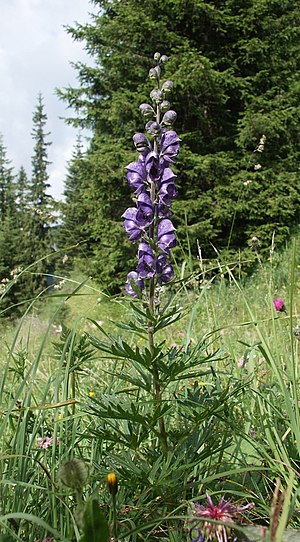Aconitum napellus: Difference between revisions
νόσημα γὰρ αἴσχιστον εἶναί φημι συνθέτους λόγους → for I consider false words to be the foulest sickness
mNo edit summary |
mNo edit summary |
||
| Line 1: | Line 1: | ||
{{lael | {{lael | ||
|lgtx=[[ἀκόνιτον]], [[ἀκόνιτος]], [[σκορπίος]], [[θηλυφόνον]] | |lgtx=[[ἀκόνιτον]], [[ἀκόνιτος]], [[σκορπίος]], [[θηλυφόνον]] | ||
}} | |||
{{wkpen | |||
|wketx=[[File:Aconitum napellus 230705.jpg|thumb|Aconitum napellus 230705]] Aconitum napellus, monkshood, aconite, Venus' chariot or wolfsbane, is a species of highly toxic flowering plants in the genus Aconitum of the family Ranunculaceae, native and endemic to western and central Europe. It is an herbaceous perennial plant growing to 1 m (3 ft 3 in) tall, with hairless stems and leaves. The leaves are rounded, 5–10 cm (2.0–3.9 in) diameter, palmately divided into five to seven deeply lobed segments. The flowers are dark purple to bluish-purple, narrow oblong helmet-shaped, 1–2 cm (0.39–0.79 in) tall. Plants native to Asia and North America formerly listed as A. napellus are now regarded as separate species. The plant is extremely poisonous in both ingestion and body contact. | |||
}} | }} | ||
Revision as of 08:12, 24 June 2024
Latin > Greek
ἀκόνιτον, ἀκόνιτος, σκορπίος, θηλυφόνον
Wikipedia EN
Aconitum napellus, monkshood, aconite, Venus' chariot or wolfsbane, is a species of highly toxic flowering plants in the genus Aconitum of the family Ranunculaceae, native and endemic to western and central Europe. It is an herbaceous perennial plant growing to 1 m (3 ft 3 in) tall, with hairless stems and leaves. The leaves are rounded, 5–10 cm (2.0–3.9 in) diameter, palmately divided into five to seven deeply lobed segments. The flowers are dark purple to bluish-purple, narrow oblong helmet-shaped, 1–2 cm (0.39–0.79 in) tall. Plants native to Asia and North America formerly listed as A. napellus are now regarded as separate species. The plant is extremely poisonous in both ingestion and body contact.

